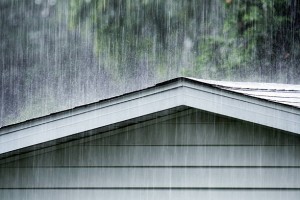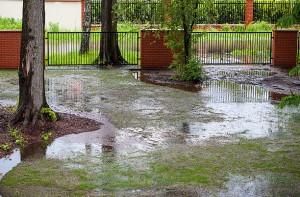February 28, 2024 |
Spring has arrived in the Chicago area, and while it is a welcome sight, it brings with it wildly fluctuating weather conditions. As rains soak the city and surrounding suburbs, homeowners everywhere may find themselves battling flooding situations. Even if your home is situated a safe distance from a body of water, you can still suffer the effects of torrential rains, as saturated or still-frozen soil allows the water to seep around foundations, into basements and crawlspaces. Therefore, we are touching on many water-related home maintenance issues. Water damage happens so easily, is very exhausting to clean, and can be terribly costly to repair, so we want to keep you well informed about protecting your home.

In addition to maintaining gutter systems, as described in a previous article, maintaining an appropriate grade around your home is equally important. Properly functioning gutters work in conjunction with proper grading around a house. The gutter’s purpose is to effectively divert water away from the foundation, but many homes will have developed a negative grade around the foundation due to settling of the soil. If water is draining from a roof into an area of negative grade, it will pool around the home’s foundation and quickly enter any cracks or windows in that area, draining into the adjacent area of the home. If you notice settling around your home, don’t be alarmed; it is a very normal occurrence and can easily be remedied.
Settling occurs as back-filled soil sinks around the new foundation, and usually happens within five to seven years after a home is built. Over time, the displaced soil settles into the air pockets around the homes foundation, causing a negative slope toward the home instead of away from it. Correcting the problem is easy, as you simply need to have additional soil added to areas of negative grade around the foundation. It is a simple solution, but not a labor-free one, so while you could certainly apply soil to the needed areas yourself, you might want to enlist the services of a local landscaper or nursery to do the job for you.
Whether you choose to complete the work yourself or hire someone, make sure that the process follows these guidelines:
- Landscaping may obscure a settling problem and may need to be removed in order to properly back-fill and correct the grading.
- The settled area should be back-filled with a heavy clay-based soil — not mulch, stone, sand, etc.
- The grade around a foundation should start six to eight inches below the siding and/or below the sill plate on the foundation.
- Grade the new material so that it is pitched at one or two inches per linear foot away from the house.
- Sometimes a high soil level can make it difficult to achieve this grade, and in these cases a swale may be added between seven to ten feet away from the house to divert water away from the foundation. French drains may also be installed to help divert water away from the house.
Hopefully this information will help you keep your home water-tight this season. If you have any questions, don’t hesitate to ask. And don’t forget, Home Inspections aren’t just for buyers or sellers – It’s always a good idea to have the condition of your home evaluated by an unbiased professional. If you would like a thorough evaluation of your current home’s maintenance needs, just contact us to schedule a Maintenance Check-Up Inspection!


